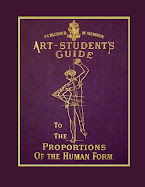


The Art of Figure Drawing: Containing Practical Instructions for a Course of Study in this Branch of Art by Charles Harvey Weigall was published by Winsor & Newton in 1852.
A copy is available online at Google Books, and a reprint of The Art Of Figure Drawing: Containing Practical Instructions For A Course Of Study In This Branch Of Art (1852)
Here is an excerpt from the section on proportion:
PROPORTION.
When we consider the variation to which the human form is subject in different parts of the globe, it seems difficult, at first, to find the standard in which beauty consists.
The consent of ages has been given to that established by the Greeks, and found in those works of that great people which remain to us.
In them we find all that can realize the idea of beauty to our minds, the symmetry of the whole, and the fitness and the adaptation of the parts being that from which nothing can be taken away, and to which nothing can be added; this standard seems indeed to be a test of truth in all matters of Art relating to the beau-ideal of human form. We have, however, not always to represent the perfection of form; and it is quite evident that no rule can be given that will answer to the countless varieties, national or individual, that come before our daily experience ; but as all these are departures from the acknowledged standard, a knowledge of that first obtained would enable us the more readily to detect them, and see wherein the difference lies. The short and squat figure of the Laplander, or the tall and muscular figure of the Caffre or Patagonian, could, by a reference to rule, be satisfactorily given on paper, by the number of heads or spaces the figure was divided into, according to the scale to be found in this work.
The physiognomical distinction between nations is also easily observable, so that we could tell at a glance the Arab from the Chinese, or the Negro from the European, and refer these differences to the given standard. The small eyes obliquely set in the head, the raised eyebrows, and the broad flat nose, would enable us to mark the Chinese; and the retiring forehead, the skull rising behind, the projecting jaws, flat nose, large nostrils, and the ears placed high up on the head, would point out the Negro : and our appreciation of the peculiarities of each, or of any other, would be obtained by the reference we insensibly make to the standard upon which our taste has been formed.
It requires, however, a nicer shade of discernment to ascertain wherein the difference lies in the physiognomy of individuals of the same nation, or of those with whom we mix in our daily intercourse; but to the Artist accustomed to observe and to note any deviation from the principle of proportion, the angle formed with the eyes and mouth, a little more acute or obtuse, the chin advancing or retiring, the high or low forehead, give at once an idea of individuality by these variations, or departures from the standard of proportion.
From the analysis and measurement of the finest Greek statues, it is to be gathered that if the grand or heroic was intended to be represented, the figure exceeded 8 heads; and if the graceful and youthful were the subject, the proportion was less than 8 heads and more than 7 1/2 the average seems therefore to be between these measures. Leaving out all the more minute fractional divisions into which the human figure has been resolved, I shall commence by dividing it into 8 heads, as the most simple rule, and one that seems to comprise the essentials of all others that have been given. This will divide the figure thus :
PLATE I.
From the crown of the head to the bottom of the chin ... 1
From the bottom of the chin to the top of the sternum, or breast bone ... 1/2
From the top of the sternum to the bottom ... 1/2
From the bottom of the sternum to just above the navel ... 1
From just above the navel to the commencement of the lower limbs ... 1
From the commencement of the lower limbs to the middle of the thigh ... 1
From the middle of the thigh to the bottom of the knee ... 1
From the bottom of the knee to the small of the ankle ... 1 1/2
From the small of the ankle to the sole of the foot ... 1/2
Heads ................................................... 8




Realistic Figure Drawing

Different Book, same title The Art of Figure Drawing

The Best of Bridgman: Boxed Set (Boxed Sets/Bindups)
















Always fascinating and useful information here. Thanks, Tom!
ReplyDeleteThanks for the compliment.
ReplyDelete